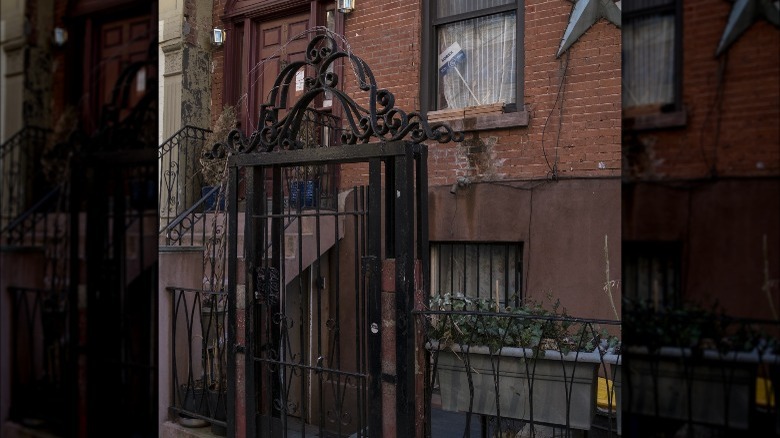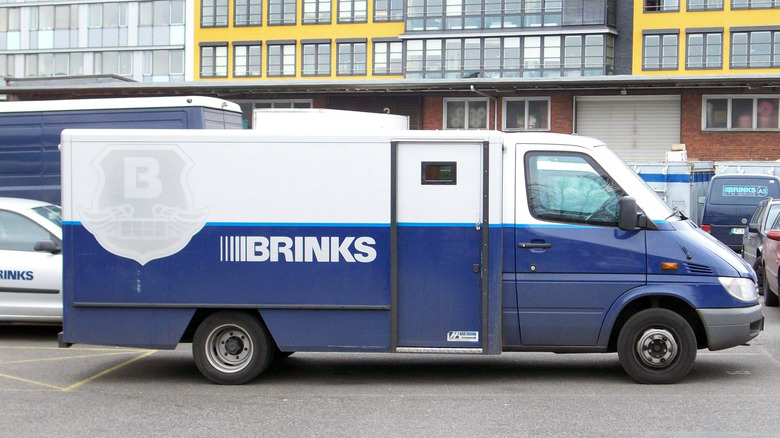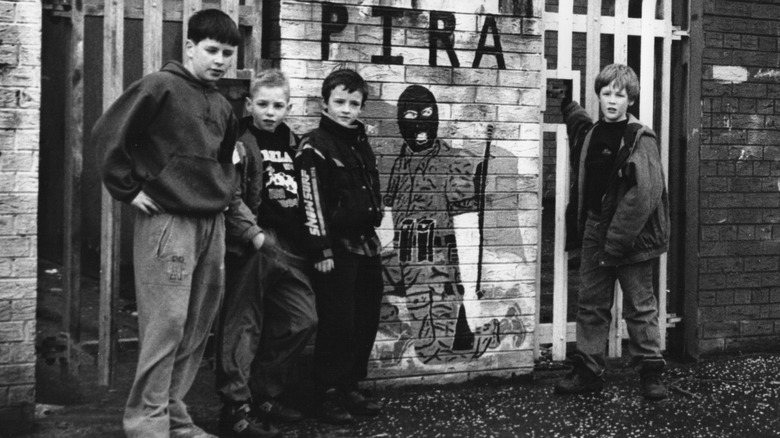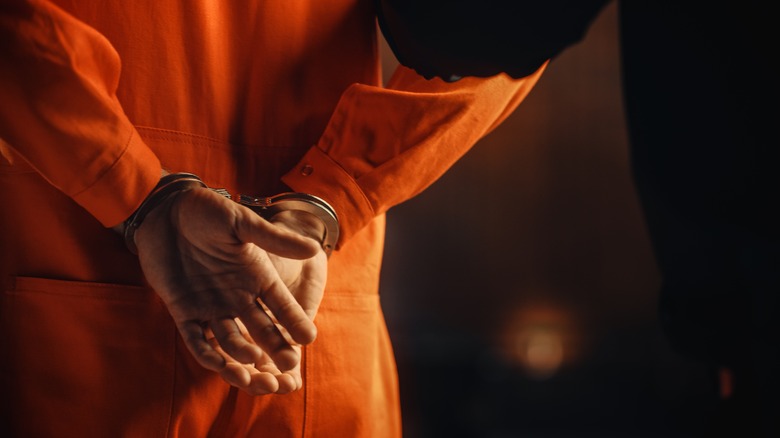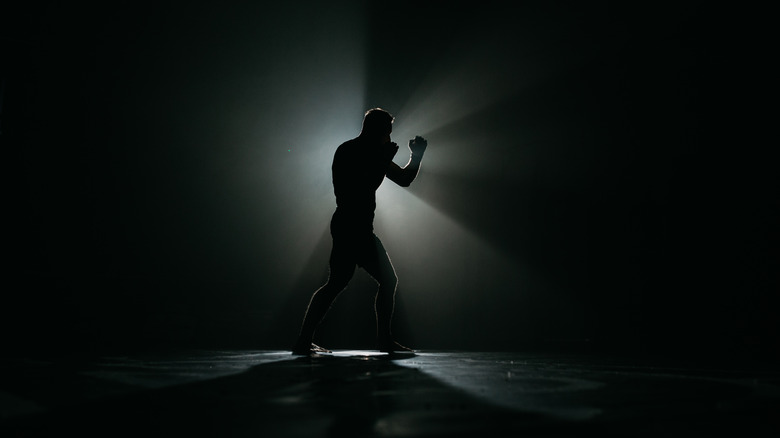The 1993 Brink's Heist Explained
We may receive a commission on purchases made from links.
Some brands are associated with safety and security, and Brink's is one of those. They have an incredibly long history: According to QSR, the company started back in 1859 with a single horse-drawn delivery wagon. By 1917, they had become a target for entrepreneurs of the shadier variety, and following a major robbery, they bought their first armored car in 1923.
Then — precisely 70 years later — they were targeted in another robbery that would become one of the nation's biggest bank robberies in history. The Buffalo News reports that thieves strolled off into the night with $7.4 million in cash, and the majority of the money remains unaccounted for ... no pun intended.
The story behind the robbery isn't a typical tale, and it's impossible to read without automatically casting the must-see Netflix movie version. Colin Farrell is definitely involved. Brendan Gleeson, as the priest? Absolutely. But what aborobinut the ill-fated boxer, just looking for his cut of the take? And the shadowy figures with faces that remain hidden to this day? That's where a little creative license can come in, but honestly, what we do know — which has come in part thanks to some serious investigative journalism and a conspirator who has no problem talking (to a point) these days — is movie-worthy alone.
Here's what went down
Let's start with the bare-bones details and talk about what happened on January 5, 1993. That, says The Buffalo News, is when a door to the Brink's armored car depot in Rochester, New York was left unlocked. Convenient? Yes, and that'll be important: It was later believed to be an inside job.
It was business as normal at first: Three guards counted a massive shipment of cash that had just come in from the nearby Federal Reserve in Buffalo. One of the guards stepped outside, and when he returned, it was at gunpoint. Suddenly, the guards were tied up, and one — Dick Popwych — would later recount (via the Democrat & Chronicle) that the man who had disarmed him had been wearing Carharts and a mask. Their demeanor made it clear that they weren't going to hesitate to shoot anyone who didn't obey quickly, so when it came time for Popwych's hands to be zip-tied behind his back, he listened. But, blinded by a bag over his head, he also listened to what they were doing and was able to tell police that he heard them leave after closing the sliding door to a van.
The thieves weren't the only ones to leave: They also took one of the guards, Thomas O'Connor, with them. O'Connor was later dropped off in the Rochester suburb of Greece, where he stumbled into a local restaurant, ordered a drink, and told them to call 911. Sounds straightforward? Buckle up.
Who was Thomas O'Connor?
Thomas O'Connor was the Brink's guard who was kidnapped by the robbers. Let's take a look at his story — and why law enforcement was so sure that he was in on it. The Buffalo News says that the ex-police officer had previously been questioned in connection with two murders — including the death of a man who had been dating his ex-girlfriend — and even more suspiciously, he had initially refused to cooperate with authorities investigating the robbery. Odd, for someone who had been a hostage? That's what they thought.
When they did a deep dive into his past, the Democrat & Chronicle reports that he was linked to the immigration of an Irishman named Samuel Ignatius Millar, and he will become crucial to the tale. Millar, they found, had connections to the Irish Republican Army and had been smuggled into the U.S. in 1984 with help from O'Connor. He had met Millar and then-girlfriend (later wife) Bernadette Fennell in Toronto, and while she drove across the border, the two men crossed by boat. Allegedly.
The three remained close friends, with O'Connor reportedly helping them settle into their new country. It was that connection that would become the lynchpin to this case: The feds were on the lookout for Millar, and O'Connor was smack dab in the center of the robbery. Then? Some of the money turned up.
Enter: Father Patrick Moloney
There's one more player in this heist that needs an introduction and some background because although it seems like an irrelevant aside, it'll all tie in soon enough.
Patrick Moloney was born in Limerick and emigrated to the U.S. in 1955. It was during his theology studies in New York City that he discovered his life's calling: Helping the city's poor. He told the Irish Independent that although America had been painted as the land of plenty, an up-close-and-personal look quickly showed him that for many, it was anything but. Over the next few decades, he became widely known for his work at Bonitas House, providing for the poor.
He was also what he described as "fiercely dedicated to the cause of Irish freedom," and was not only a devout priest but also a devout Republican, serving as an active voice in calling for an Ireland once again united under Irish rule. During one of his many trips home, he was arrested after being misidentified. Much, much later, he explained that he had spent a good part of his life accused of being part of a secretive group deep within the IRA. Accusations of IRA sympathies and his work with sheltering undocumented immigrants meant that Moloney had attracted the attention of the FBI. That, says The Buffalo News, is how the feds ended up being at the right place at the right time to recover some of the cash that went missing from Rochester's Brink's.
There were hints that it was an inside job
When the heist went down, law enforcement had a valuable asset: Thomas O'Connor. As an ex-police officer, it would have been logical that he could provide insight and observations that a civilian perhaps would have overlooked. But according to the Democrat & Chronicle, O'Connor initially refused to be interviewed. When he did talk, it didn't take long for suspicions to kick in.
The Los Angeles Times says that it took O'Connor four days to hand over a deposition about the robbery — unlike the other two guards, who had been forthcoming with testimony and a willingness to take a polygraph test. (Both passed, while O'Connor refused to take one.) O'Connor's testimony had some glaring holes — literally — starting with his claim that he had been blindfolded with a knit hat pulled down over his face ... which isn't exactly impossible to see through.
He also said that the robbers had instructed him to man both the phones and the doors while they transferred the money to their vehicle, and that was another inconsistency ... not to mention that unlocked door. Furthermore, while O'Connor testified that he had been taken in a moving van, evidence — including tire tracks — suggested that it had been a minivan. No money was ever found in his possession, and much later, Sam Millar would write a biography and say that he'd had nothing to do with the robbery. Still, authorities felt they had enough to arrest him ... eventually.
$2 million was found a few months later
The Los Angeles Times says that it was in November 1993 that FBI surveillance set up at an apartment building in Manhattan led to the recovery of about $2 million. (Fun fact: $2 million in $20 bills weighs about 350 pounds!)
The apartment belonged to a man named Charles McCormick, and he was, of course, arrested in connection with the find. At the same time, three other men were arrested as well: Thomas O'Connor, the guard working at the Brink's depot when it was robbed; his friend, Sam Millar; and Father Patrick Moloney. According to FBI documentation, the four were connected with an organization called Irish Northern Aid, or NORAID. Officially, NORAID is a U.S.-based organization dedicated to things like education on Irish history and language, along with promoting the idea of a united Ireland. At the time, though, some members were suspected of fundraising in the U.S. and sending that money to the IRA. By the time the $2 million was found, the FBI suspected that the other $5 million, give or take, had already been shuffled off across the pond, likely via trans-Atlantic couriers and money orders — like those they had records of Millar buying.
When Sam Millar was arrested, his neighbors were baffled
So, who is Sam Millar? According to The New York Times, Millar was known to his Queens neighbors as a mild-mannered, family-man sort of guy, who lived in an apartment with his wife and three kids, drove a minivan, and ran a comic book shop. Once he was arrested in connection with the Brink's robbery, though, another side of him went public.
Millar, it turns out, had not just been a well-known member of the IRA. He had also been arrested and sentenced to eight years in a Northern Irish prison that Gerry Adams — head of the Irish political party Sinn Fein — had once described as "Britain's concentration camp." Once Millar made his way to the U.S., he spent some time officially working as an Upper East Side doorman, and unofficially collecting cash for underground, Irish-run casinos.
Did he organize the Brink's heist in order to funnel some serious cash back to his old IRA connections? Law enforcement certainly thought so, and after pointing to an apparently sudden windfall of cash that allowed him to head out on vacations, buy incredibly rare — and expensive — comic books, and ditch his minivan in favor of a new SUV, he was arrested.
Convictions and acquittals
Here's the thing about getting a conviction: Law enforcement needs evidence to put away those they're accusing of a crime, and although they were connected with the $2 million recovered from the Manhattan apartment, there wasn't a whole heck of a lot of evidence actually linking any of the men — Sam Millar, Thomas O'Connor, Father Patrick Moloney, and Charles McCormick — to the 1993 Brink's heist.
In November 1994, the Associated Press reported on the outcome of the seven-week trial that had ended with a jury debating for nearly three days. Their verdict was pretty shocking: O'Connor and McCormick were acquitted of any and all charges in their entirety. As for Millar and Moloney? They were found guilty, but not of masterminding the robbery itself. The guilty charge that stuck was "conspiring to possess money from the robbery." Of the $2 million recovered from the Manhattan apartment, the serial numbers on $107,000 of it matched what was stolen from the Brink's depot. Interestingly, prosecutors had agreed to completely drop the IRA angle from the trial and instead concentrated on the money that the accused had come into possession of.
Moloney and Millar served their time
Sam Millar ultimately served four years, and according to The New York Times, part of that was done overseas. During the Bill Clinton presidency, Millar was part of a transfer program that saw many inmates moved — and for him, it was back to Ireland. As he later told the Belfast Telegraph, one of the last things Clinton did as president was to give him a full pardon.
Moloney served five years, and while he was originally sent to a federal prison in Pennsylvania, the Irish Independent says that he was moved to a facility in Minnesota. Moloney continued to maintain his innocence and was supported by not only the community he had done so much for in New York City but by the Catholic Church. During his incarceration, Moloney wasn't shy about saying exactly what he thought of the entire thing, later reflecting, "They had no iota of a shred of evidence that I had been involved in the actual robbery." He went on: "In the system I was treated badly. I was treated as badly as if I was [notorious mobster, John] Gotti or someone. They black boxed me, meaning they put your hands in a device so you can't even feed yourself." He also noted that while he had to fight for his religious freedoms, his fellow inmates revered him ... whether they believed him an innocent martyr, or a modern-day jo.
With $5 million missing, Bernadette Fennell was questioned
The somewhat ambiguous end of the trial of Sam Millar and his alleged associates wasn't the end of the investigation. The following summer, Millar's wife, Bernadette Fennell, was sent a subpoena to testify in regard to conversations that she may have been involved with or overheard. At the time, there was still more than $5 million missing, and that's not the sort of thing that tends to be taken lightly.
According to the Democrat & Chronicle, Fennell's testimony led absolutely nowhere — and, in spite of the missing money, it seemed as though things were kind of wrapped up. Investigative journalist Gary Craig — who would go on to write the book "Seven Million: A Cop, a Priest, a Soldier for the IRA, and the Still-Unsolved Rochester Brink's Heist" — speculated that there wasn't much more out there to be discovered about the robbery ... but that wasn't entirely the end of the story. At the same time that Fennell was being summoned to court, there was another player in the game who had shown up looking for his cut of the money ... and then, he disappeared.
The disappearance of Ronnie Gibbons
There's one more chapter to the story, and that's the tale of a boxer named Ronnie Gibbons. According to The New York Times, Gibbons had confided in friends that he had been in on the planning of the Brink's heist with Sam Millar and Patrick Moloney. There had been one thing that he hadn't agreed with them on, though, and said that when they were adamant about using guns, Gibbons backed out.
However, he told those same friends that he still wanted a cut of the money. Two years had passed, and after he said he was going to confront his one-time partners and demand his share, he disappeared. After reporting on Bernadette Fennell's subpoenaed testimony, the Democrat & Chronicle noted that they were probably going to be reporting more on the disappearance of Gibbons, as opposed to their long-running coverage of the robbery. And they did — for a long, long time.
Investigative reporter Gary Craig wrote that he had kept in touch with Gibbons's family, and continued to promise them that he hadn't been forgotten. Still, it must have seemed like he had been: It wasn't until 2015 that unidentified remains were exhumed from where they had been buried. The torso and foot were all that had washed up on the shores of Lake Ontario, and DNA testing confirmed they belonged to the missing Gibbons. He'd last been seen alive in 1995, and the investigation into his death turned up no leads.
Where are they now?
So, what happened to the men connected to one of the most infamous armored car robberies in the nation's history?
Thomas O'Connor died in 2013, and according to investigative journalist Gary Craig of the Democrat & Chronicle, he had consistently refused to talk about the heist. When The Village Sun caught up with Father Patrick Moloney in 2020, the then 88-year-old priest still maintained that he was innocent ... while, the publication notes, being happy to talk about all the ins and outs of the case. He was still working at the Bonitas House, running his youth shelter, keeping clippings about his maybe-involvement, and looking forward to seeing some documentaries made.
And Sam Millar? The Irish News reports that he's back living in his native Belfast, where he's become a successful crime novelist. One of his books, "On the Brinks," is his true story of how the Brink's heist went down. As he told the Belfast Telegraph, it was absolutely his idea. After talking a bit about his time in the IRA and his jail sentences in Belfast, he said, "But then I got myself into a lot more trouble in the U.S., when I got involved in the Brink's robbery — the biggest robbery in U.S. history. ... Before I was caught, I'd spent a good bit of money because I was tipped off that the FBI knew who had done the robbery... and that it was only a matter of time."



